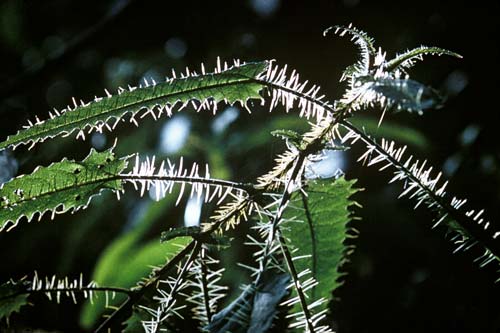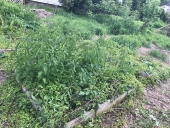
 6
6




"The rule of no realm is mine. But all worthy things that are in peril as the world now stands, these are my care. And for my part, I shall not wholly fail in my task if anything that passes through this night can still grow fairer or bear fruit and flower again in days to come. For I too am a steward. Did you not know?" Gandolf
 3
3








 I would love some seeds of her.
I would love some seeds of her.
Idle dreamer








Dana Jones wrote:Tyler are you out of your mind? You REALLY WANT these demon plants to grow on your land??
I just looked up Mala Mujer and indeed, they are one and the same. The article I was reading had comments and one said he dug up a root 4' long and bigger around than his leg. Geesh! No wonder they are so hard to kill!
 1
1








 1
1




 1
1




Kyrt Ryder wrote:
Dana Jones wrote:Tyler are you out of your mind? You REALLY WANT these demon plants to grow on your land??
Tyler's very interested in native food plants. Furthermore- AFAIK- she's very interested in biomass plants that grow successfully and easily without irrigation.
I just looked up Mala Mujer and indeed, they are one and the same. The article I was reading had comments and one said he dug up a root 4' long and bigger around than his leg. Geesh! No wonder they are so hard to kill!
Sounds like a solution to me. Keep cutting it back in the summer and use that root to keep growing biomass as you chop it out. Eventually it'll give up.




Idle dreamer

 2
2




Marco Banks wrote:My nettle experiment is officially over. I pulled them out today.
 1
1




"People may doubt what you say, but they will believe what you do."




Invasive plants are Earth's way of insisting we notice her medicines. Stephen Herrod Buhner
Everyone learns what works by learning what doesn't work. Stephen Herrod Buhner




Joseph Lofthouse wrote:
You really think that will end the experiment?
Trying to achieve self-reliance on a tiny suburban plot: http://gardenofgaladriel.blogspot.com





"People may doubt what you say, but they will believe what you do."




Todd Parr wrote:You can get rid of them by covering them with something that will not break down. I use black rubber sheeting over the area. It takes a while, but much less than 13 years
 But to tell the truth, I haven't been trying too hard as I find it to be pretty useful in general, whether as food, medicine, compost, or intruder deterrent. When my suppy exceeds demand, I just chop and drop them.
But to tell the truth, I haven't been trying too hard as I find it to be pretty useful in general, whether as food, medicine, compost, or intruder deterrent. When my suppy exceeds demand, I just chop and drop them. Trying to achieve self-reliance on a tiny suburban plot: http://gardenofgaladriel.blogspot.com




Best luck: satisfaction
Greatest curse, greed









Best luck: satisfaction
Greatest curse, greed




Trying to achieve self-reliance on a tiny suburban plot: http://gardenofgaladriel.blogspot.com




Best luck: satisfaction
Greatest curse, greed




"People may doubt what you say, but they will believe what you do."




I had a pigmy goat as a pet 15 years or so ago and she loved nettles. Or at least loved stripping the leaves off them, don't recall which for certain.Thekla McDaniels wrote:Does anyone know if goats will eat them?




With forty shades of green, it's hard to be blue.
Garg 'nuair dhùisgear! Virtutis Gloria Merces




Karen Layne wrote:
Nettle stings are supposed to be good for you too ( just like honeybee stings are good for arthritis), haven't tried either of these (on purpose) yet either. Just what I've always heard.
For those stung and bothered by nettle, there's an old saying - "Nettle in dock out, dock takes the nettle out." So if you've got some dock nearby, try it. I'm sure plantain works too, that's what I use for bee stings/ bug bites.
"The rule of no realm is mine. But all worthy things that are in peril as the world now stands, these are my care. And for my part, I shall not wholly fail in my task if anything that passes through this night can still grow fairer or bear fruit and flower again in days to come. For I too am a steward. Did you not know?" Gandolf
 3
3




"The rule of no realm is mine. But all worthy things that are in peril as the world now stands, these are my care. And for my part, I shall not wholly fail in my task if anything that passes through this night can still grow fairer or bear fruit and flower again in days to come. For I too am a steward. Did you not know?" Gandolf
 1
1




A human being should be able to change a diaper, plan an invasion, butcher a hog, conn a ship, design a building, write a sonnet, balance accounts, build a wall, set a bone, comfort the dying, take orders, give orders, cooperate, act alone, solve equations, analyze a new problem, pitch manure, program a computer, cook a tasty meal, fight efficiently, die gallantly. Specialization is for insects.
-Robert A. Heinlein
 3
3








A human being should be able to change a diaper, plan an invasion, butcher a hog, conn a ship, design a building, write a sonnet, balance accounts, build a wall, set a bone, comfort the dying, take orders, give orders, cooperate, act alone, solve equations, analyze a new problem, pitch manure, program a computer, cook a tasty meal, fight efficiently, die gallantly. Specialization is for insects.
-Robert A. Heinlein
 2
2









Phil Stevens wrote:I can attest that nettle soup is a perfectly agreeable dish. By the time those leaves are pureed there's no hint of fuzz and of course heat denatures the sting.
 5
5




 3
3




Porch sitting is my favorite thing







 1
1





 2
2




john Harper wrote: I agree that they are best kept in your zone 5, or if necessary, in an escape proof bed. In Eastern Kansas, nettles are one of the first perennials to put up shoots in the Spring, and are a welcome source of greens.
![Filename: I-love-my-nettle-.png
Description: My zone 5 is at the top of the hill and in the woods. Waaay to far to go while watching kids or in a hurry to get dinner started! [Thumbnail for I-love-my-nettle-.png]](/t/56417/a/68626/I-love-my-nettle-.png)
 1
1





Cultivate abundance for people, plants and wildlife - Growing with Nature







 3
3




Moderator, Treatment Free Beekeepers group on Facebook.
https://www.facebook.com/groups/treatmentfreebeekeepers/





 1
1




Michael Cox wrote: My casual observation is that nettles that grow on edges of woods - heavy shade, but sunlight on one side - tend to be broader leaved, less hairy, and less coarse. They are generally softer and more palatable. The ones that grow in direct sunlight have smaller, coarser leaves.
 5
5




"The rule of no realm is mine. But all worthy things that are in peril as the world now stands, these are my care. And for my part, I shall not wholly fail in my task if anything that passes through this night can still grow fairer or bear fruit and flower again in days to come. For I too am a steward. Did you not know?" Gandolf

|
This guy is skipping without a rope. At least, that's what this tiny ad said:
permaculture and gardener gifts (stocking stuffers?)
https://permies.com/wiki/permaculture-gifts-stocking-stuffers
|






